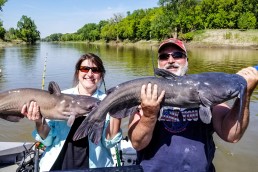Use the Barometer for Catfishing Success
SHARE THIS POST
Brad Durick understands how fish are affected by changes in barometric pressure, and what to do to keep fishing through those changes.
No matter what you fish for, it seems there is no weather topic more debated than barometric pressure. Over the years, I’ve heard many different barometric theories that affect fish. Some I believe (maybe), and some are so far-fetched that all I can do is laugh. There is one thing about barometric pressure that I know for sure is absolute law, fish know it changes.
In 2011, I was guiding a gentleman who was writing a book about catfishing. In his professional life, he was an engineer in the space program. He insisted that air pressure could have no significant effect on water pressure based on the small amount it moved on the barometer. He instead said the barometer is an indicator of sunlight and that the fish follow the sunlight which is why when the barometer is high fish get sluggish sometimes, because of the full light of a bluebird sky. He also mentioned that the falling barometer corresponded with cloudiness.
While I have never bought into all of the theories of this conversation, it did make me start thinking and take some notes. I do believe that the barometric pressure plays a role in fishing, and contrary to what many believe, it even affects catfish.
Here is what we know: catfishing tends to be good when the barometer is stable or falling. After a big front, the catfishing can get tough from a couple hours to a couple days.
When you have a south wind and the barometer is slowly dropping, catfish usually get out and feed actively on the current seams, outside edges of snags, and at the front of holes. This is also the case if there is very little movement in the barometer.
Once a front passes through, the bite may slow down. You might find the fish tighter to the snag, deeper in the hole or closer to the bank. When fishing in a river, they go from in the current to out of the current.
Every so often, the local weatherman starts talking about a big storm a few days down the road. The barometer usually drops slowly a few days in advance of such storms, and the fishing tends to get better, with the fish behaving more aggressively the closer the storm gets. This continues right up until the storm hits, then the wind changes to he northwest and the bite shuts down. The question is why?
Are you enjoying this post?
You can be among the first to get the latest info on where to go, what to use and how to use it!
This is where my non-scientific theory comes into play. I have witnessed it firsthand enough times to know that there is something to it. I believe that the catfish know something is going to happen. They can feel the change, and they begin to prepare for a negative. They don’t have a weatherman to tell them what to expect, so they feed and gorge in preparation. I believe that once the front passes, the fish go off and rest. Another reason they don’t bite is that they are simply full.
Obviously, we anglers need to adjust to what happens if we wish to catch fish. This is where the term “lateral movement” comes into play. The fish move out of the heavier current and aggressive feeding areas to spots with the least resistance, so they can expend the least amount of energy during this time. Once the storm hits, catfish head for cover and wait out the storm.
We know they are in areas where they expend the least amount of energy. We also think the fish are full. To catch them, put bait in the high percentage areas off current and in tight cover, and wait. Instead of a 15- or 20-minute sit, like normal, we have to give them 30 or even 45 minutes to find the bait and decide if they are going to eat it.
It is also a good idea to downsize bait to prevent short bites. Negative catfish have a habit of picking at the bait and biting under the hook, making you think you have a fish. But, when you take a couple cranks, they let go, leaving you with a smashed bait.
Understanding changes in barometric pressure and how it affects fish allows us to make the necessary adjustment that can take us from a total shutdown to a good day of fishing.
If you like catfishing, then you’ll enjoy the August issue of MidWest Outdoors, available the first full week of August at the newsstand or by subscribing on our website.
MWO
SHARE THIS POST
You may also like...
Nothing found.
Did you enjoy this post?
You can be among the first to get the latest info on where to go, what to use and how to use it!
Brad Durick
Captain Brad Durick is a nationally recognized catfish guide, seminar speaker, and author of the books Cracking the Channel Catfish Code and Advanced Catfishing Made Easy. For more information: redrivercatfish.com or facebook.com/braddurickoutdoors.
